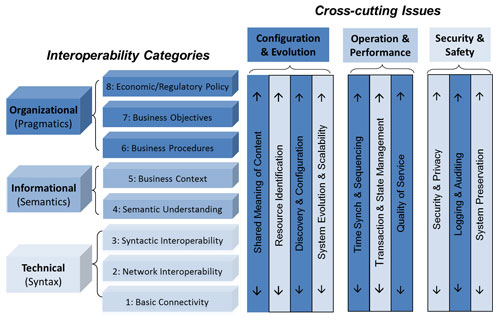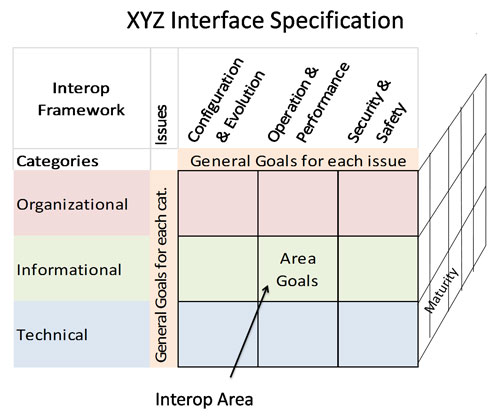Smart Grid Interoperability Maturity Model Summary
The integration of automation associated with electricity resources (including transmission and distribution automation and demand-side resources operated by end-users) is important to supporting greater efficiencies and incorporating variable renewable resources and electric vehicles into the power system. The integration problems faced by this community are analogous to those faced in the health industry, emergency services, and other complex communities with many stakeholders. To highlight this issue and encourage communication and the development of a smart grid interoperability community, the GridWise® Architecture Council (GWAC) created an Interoperability Context-Setting Framework (see Figure S.1). This “conceptual model” has been helpful to explain the importance of organizational alignment in addition to technical and informational interface specifications for “smart grid” devices and systems. As a next step to building a community sensitive to interoperability, the GWAC has been developing a Smart Grid Interoperability Maturity Model (SG IMM) borrowing from work done by others to address similar circumstances. The model provides a means to measure status and progress, analyze gaps, and prioritize efforts to improve the situation. The objective is to create a tool, or set of tools, that encourages a culture of interoperability in the smart grid community.

An Interoperability Improvement Process
To achieve interoperable products and systems, the interfaces between them need to be clearly specified with well-defined responsibilities and expectations understood between the interacting parties. The SG IMM was inspired by work done by the National e-Health Transition Authority of Australia (NEHTA), which articulated the adaption of capability maturity model concepts from the Software Engineering Institute at Carnegie Mellon University (SEI) to go beyond a corporate enterprise and address the need to exchange medical information between the multitude of stakeholders in the health community. The issue in the health system, as well as the electric system, is developing and improving interface standards that allow the many players to easily connect, effectively communicate, and enable automation to deliver value in new ways.
An ecosystem of products and systems that collaborate to provide useful services begins with pair-wise communications between parties that may be ad hoc at first, but eventually get documented. Project-level interface specifications may be shared with other parties as the concepts and value propositions mature. Communities of interested organizations may come together under the umbrella of a standards organization to develop one or more standards, and implementations that support these standards may eventually be tested and certified by testing authorities to meeting the requirements of the standards. As technology and value propositions advance, the performance of the standard may be measured. This information can be used to identify and prioritize changes to the standards, resulting in new versions of the standards and associated tests. These steps represent progress in the maturity of the interoperability of the products and systems that service the community. By developing processes that move the community to higher levels of maturity, the discipline to improve interoperability can advance.
A Structure for Exploring the Full Dimensions of Interoperability
A model for this progression in software development, called a capability maturity model, has been articulated by SEI and is widely embraced as a process improvement approach for developing quality software and systems. The five maturity levels in this model are used in the SG IMM as a maturity measure for interoperability by the SG IMM. As the GWAC Interoperability Context-Setting Framework provides a mechanism for exploring the multiple dimensions of interoperability, the SG IMM used this model as an organized landscape for identifying interoperability goals. The SG IMM transforms these goals into a series of metrics. Statements about the characteristics expected at each maturity level are then used as tests for evaluating the maturity of an interface specification of interest. Figure S-2 depicts a simplified view of the framework with the maturity levels incorporated as a third dimension.
The SG IMM aims to enhance the quality of interface specifications used in the smart grid community. The efficiency of the integration between the different devices and systems and the reliability of the integration experience are strong reasons that justify the efforts required to define good metrics that can indicate the level of interoperability maturity.

Moving Forward
The GWAC is releasing an initial (beta) draft of this model to introduce the concepts and solicit participation by interested stakeholders to develop these ideas into a workable model with an assessment methodology and tools. As such, the statements deserve careful scrutiny. Those who have contributed to this work recognize the need for improvement. Besides advancing the SG IMM to a useable product, more participation is needed to socialize the concepts and help with the adoption of the ultimate model by our smart grid community. With this in mind, this draft model is undergoing early tests in a set of trials. Two such trials are now underway and the team is soliciting the involvement of other application areas to trial the initial evaluation tool. In addition, a workshop is being planned to bring together smart grid integration and process improvement experts for a review of the SG IMM beta in the first part of 2012. The results of the workshop and the trials are expected to provide necessary feedback so that the beta document can be advanced to a version 1.0 of the SG IMM. Additional experience and new participants are also expected to reveal new uses for the model and different directions that evaluation methods and tools can take. Other documents and efforts will hopefully follow as these ideas endeavor to make interoperability part of the smart grid deployment culture.
The SG IMM is also not the only work product advancing maturity in the smart grid community. Cyber security approaches are also maturing and a functional maturity model for electric utilities has already been established called the SGMM, which also happens to be managed by SEI. Discussions have been initiated with the U.S. Department of Energy and SEI on the potential to coordinate the SGMM efforts with the SG IMM. Based on the complementary nature of the models and their intent to advance maturity in the smart grid community, benefits should be able to be realized through collaboration.
In summary, the GridWise Architecture Council (GWAC) mission is to enable interoperability among the many entities that interact with the electric power system. The development of the Smart Grid Interoperability Maturity Model (SG IMM) represents a crucial step towards defining metrics for determining the current quality and levels of interoperability among the interacting entities. It defines a measurement model for determining the interoperability aspects of the interfaces between various entities in the electric power system.

